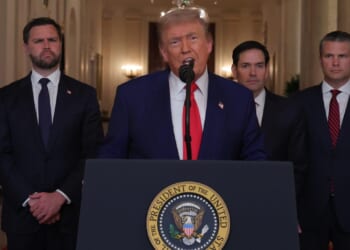Xander West is an independent writer and author of the Grumbling Times substack.
The rather media-generated phenomenon around a Conservative-Reform alliance of one kind or another has been a source of some consternation in recent political affairs.
Despite probably every shadow minister refuting such suggestions and Reform’s leadership being completely uninterested, ‘rumours’ persist to the Conservative Party’s detriment.
This is because a few Conservatives, including politicians, still support the idea. The more learned of these cite the Liberal Unionists as a successful centre-right coalition in the party’s past.
In fact, the conditions which made that alliance possible form a case against the notion of repeating it today (if its inherent implausibility, unfeasibility and air of capitulation were not convincing enough).
The formation of the Liberal Unionists stemmed from the consequences of the 1885 general election, which produced a hung parliament with the nationalist Irish Parliamentary Party holding the balance of power. William Gladstone, longtime leader of the Liberal Party, committed himself to Irish Home Rule in response, and thus formed a government.
However a large portion of Liberal opinion, believing self-government in Ireland would lead to its independence and the dissolution of the Union, renounced Gladstone’s leadership and formed the Liberal Unionist Council. Within seven months, Gladstone managed to split his party, fall on the second reading of the Home Rule Bill and decisively lose the ensuing general election in July 1886.
The Conservatives took office on the basis of an electoral pact with the Liberal Unionists, followed by informal cooperation in Parliament rather than a coalition, which their leader Spencer Cavendish, Marquess of Hartington, believed would lose them standing with their base of former Liberal voters.
It took until 1895, following a second Gladstone-Irish government attempting to pass Home Rule, for the Liberal Unionists to join the Conservatives in government, by which point their separate identity was fading. This Unionist coalition held until the government resigned in December 1905; the two parties ultimately merged in 1912 into today’s Conservative and Unionist Party.
The reason for the success of the Conservatives’ pact with the Liberal Unionists was a matter of composition. The Liberals had always been a heterogenous grouping, and in the years before 1886 were increasingly split between their foundational Whig and Radical factions.
The Radicals had used the emergence of mass politics to accelerate their organisation and demands in an attempt to take the party initiative and shift Gladstone’s governments leftwards. Meanwhile the Whigs, derived from the aristocracy as well as some of the newer class of self-made industrialists and businessmen, were the moderating force of the party, to the extent of occasionally producing quite conservative administrations under figures like Henry John Temple, 3rd Viscount Palmerston.
Gladstone originated from neither faction but was no Radical, yet before the Home Rule crisis certain Whigs had grown disillusioned with his leadership and ability to defend the party against Radicalism. Hence, those who created the Liberal Unionists were overwhelmingly Whigs, acting on the conservative instinct of protecting the Union and the belief Gladstone was no longer prepared to restrain the pace of change.
Initially, they still perceived themselves as guardians of a particular conception of liberalism instead of conservatism, especially in the House of Lords, where the traditional noble families almost prided themselves on having recreated an independent Whig Party.
Nevertheless, there was a similarity of temperament and even outlook with the Conservatives, which through what turned out to be long-term common interests in opposing Home Rule and socialism drew most Liberal Unionists closer to conservative positions as the alliance continued.
However, there was also an incongruous yet vocal minority of Radicals which defected, led by the Whigs’ arch-rival Joseph Chamberlain and his National Radical Union. His was a later, unexpected and rather unwelcome arrival, predicated on a ploy to force the ageing Gladstone’s retirement on Home Rule’s defeat and take leadership of the Liberals himself.
Given his dogmatic Radical ideology, Chamberlain placed himself in opposition to Hartington’s Liberal Unionists and sharing platforms with the Conservatives, not that he was liked by either.
This plan, and his attempt to reconcile with the Liberal Party in 1887, both failed, leaving him isolated with at most a dozen MPs under his command, half from his electoral stranglehold over Birmingham. Until Chamberlain succeeded Hartington, who became Duke of Devonshire in the Lords, as Liberal Unionist Commons leader in 1891 and joined the coalition government in 1895, his Radical contingent was rarely a concern and struggled to influence the alliance in any meaningful way. (Later events, of course, saw him fight both parties for control.)
Now consider Reform. The composition of its leadership – the only individuals with any real influence over its affairs – is practically the inverse of the Liberal Unionists: heedlessly radical attitudes predominate, and the conservative-minded are nowhere to be found.
Moreover, one of Reform’s principal aims is to destroy the Conservative Party, something which for the Liberal Unionists would have compromised all their key positions. Every indication shows this easily outweighs the theoretical common interest in defeating Labour at the next general election.
Forming the next government alone, as Reform’s leadership unshakeably believes it shall, necessitates the destruction of the Conservatives; thus a pact is impossible, and no basis for one could exist.
What should the Conservatives do instead? After all, the intransigent hostility of Reform’s leadership may not extend to the entire membership if the Conservatives recover. Robert Jenrick has spoken about creating a “coalition of voters” within a changed Conservative Party, rather than any multi-party pact, in which all natural conservatives can once again trust.
This seems a much more sensible approach, with at least a chance of success. Really, there can be no other strategy for returning to government, since it is now imperative to the party’s survival that a broad range of voters can be persuaded anew that conservatism is a competent force for good and only one party can provide such a programme for government.
Natural conservatives deserted the party because conservatism means more than whatever the Conservative Party does in government. Indeed, given the previous government has such a sour legacy, the party has no choice but to pursue a new direction. Since Reform’s proclamations have evolved into an attempt to subsume the entire political spectrum, an opportunity for reviving at least some of the voting coalition is slowly presenting itself.
Of course, this is no excuse for passivity, for which the only reward would be permanent oblivion. Jenrick has realised perhaps the most of all Conservative politicians the extraordinary work still required to reunite natural conservatives, let alone form the next government – amounting to a fundamental transformation of the party in a rather shorter order than will be necessarily comfortable.



![Former Bravo Star Charged After Violent Assault Using a Rock-Filled Sock in Tennessee Walmart [WATCH]](https://www.right2024.com/wp-content/uploads/2025/07/Former-Bravo-Star-Charged-After-Violent-Assault-Using-a-Rock-Filled-350x250.jpg)



![NYC Man Snatches Child Off The Sidewalk, Parents Chase Him Down [WATCH]](https://www.right2024.com/wp-content/uploads/2025/07/NYC-Man-Snatches-Child-Off-The-Sidewalk-Parents-Chase-Him-350x250.jpg)
![Karoline Leavitt Levels CNN's Kaitlan Collins and Other Legacy Media Reporters [WATCH]](https://www.right2024.com/wp-content/uploads/2025/07/Karoline-Leavitt-Levels-CNNs-Kaitlan-Collins-and-Other-Legacy-Media-350x250.jpg)
![Man Arrested After Screaming at Senators During Big Beautiful Bill Debate [WATCH]](https://www.right2024.com/wp-content/uploads/2025/06/Man-Arrested-After-Screaming-at-Senators-During-Big-Beautiful-Bill-350x250.jpg)

![Leftists Lose Their Minds After Jason Kelce Celebrates Being an American [WATCH]](https://www.right2024.com/wp-content/uploads/2025/07/Leftists-Lose-Their-Minds-After-Jason-Kelce-Celebrates-Being-an-350x250.jpg)





